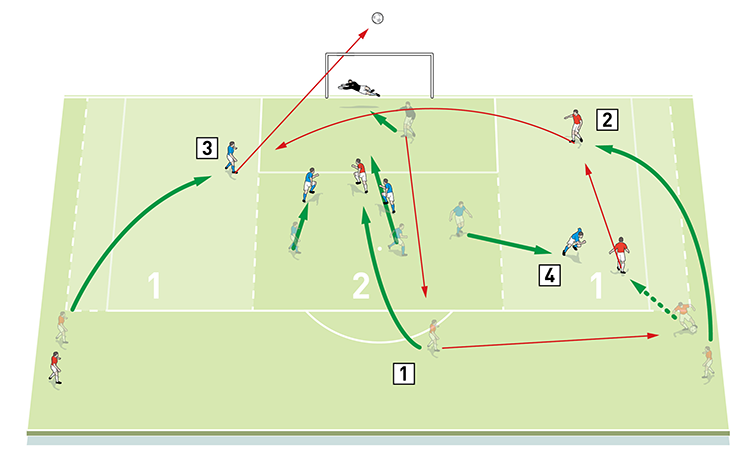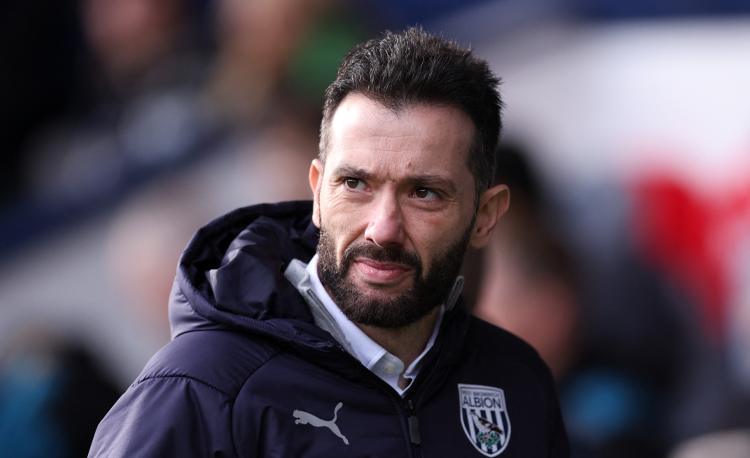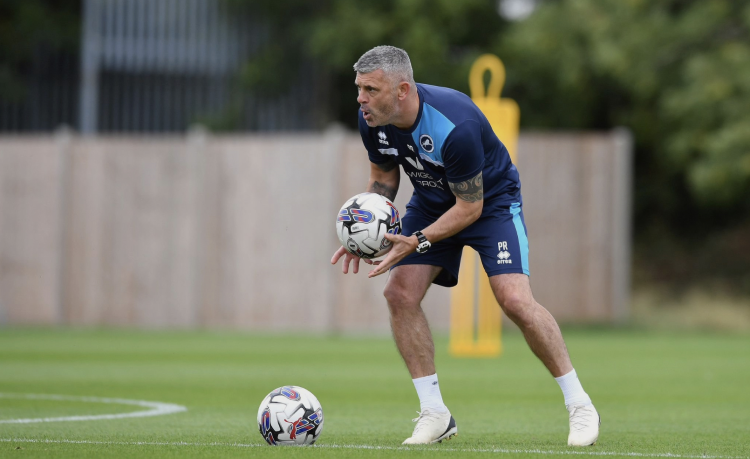You are viewing 1 of your 1 free articles
Defending the danger zone
This session is designed to work on defending in the ‘danger zone’, but it also works on attacking in the danger zone too. Studies have shown that a significant proportion of goals have been created from the zone 1 area, where a greater number of assists are expected to occur, so it’s important that attackers are drilled to capitalise on this and defenders are trained to react accordingly.
| Area | Up to half a pitch |
| Equipment | Balls, bibs, cones, 2 small goals, 2 full size goals |
| No. of Players | Up to 18 players + 2 goalkeepers |
| Session Time | Each activity: 10mins |
This session is designed to work on defending in the ‘danger zone’, but it also works on attacking in the danger zone too. Studies have shown that a significant proportion of goals have been created from the zone 1 area, where a greater number of assists are expected to occur, so it’s important that attackers are drilled to capitalise on this and defenders are trained to react accordingly.
This session can be used with a defensive emphasis or an attacking emphasis, depending on what it is we are trying to achieve. We often use this as a defensive session because it is important for defenders to practise in realistic 1v1 or 2v2 situations, as this is an area where you always need to improve. We don’t spend too long on each drill and vary the sessions, so sometimes we will only do one or two of the exercises before moving onto a conditioned game or free play.
We often do some defensive work with the players on a Tuesday, as long as we don’t have midweek fixtures. Throughout each week we will always work on shape and prepare for the next match, but it is important to ensure the defenders also have the opportunity to practise defending.
We would vary the type of sessions depending on who we are playing against, but often this session would be used if we were playing a team that is really good at getting the ball in behind the defence and into zone 1.
What do I get the players to do?
Defending 1v1
We set up an area slightly wider than the penalty box but the same depth, with a goal and a goalkeeper in their normal positions. We divide the area into zones, with a central zone (zone 2) the width of the six-yard box and two wide zones (zones 1) on either side. We position two mini goals facing out to the wings, as shown [1]. We’re using 18 outfield players, split into eight blue defenders and ten red attackers. Four red defenders line up on each side of zone 2. Eight blue attackers wait in two lines outside the penalty area facing the ‘D’ and a wide attacker waits on each side near the corner of the penalty box ready to receive a pass.
1

2. The first defender on each side moves into zone 1 ready to go 1v1 against the wide attacker
3. The wide attacker should try to score in the mini goal
4. If the defender wins the ball, it should be cleared out of the area
The goalkeeper starts play by passing to the first attacker facing the ‘D’. The attacker then passes to the wide player. As the ball is played, one defender moves into zone 1 and goes 1v1 against the wide attacker. The wide player should try to score in the mini goal and the defender must try to stop him. After taking a shot, or when the ball goes dead, the goalkeeper restarts play to launch an attack on the other side of the penalty area. Attackers rotate into the wide role so everyone has a go in the position.
We want to see the defenders working on their speed to the ball and using the correct body position and angle of approach.
Defending 2v2
We use the same basic set-up as before but we remove the two mini goals. We’re using at least 10 outfield players and a goalkeeper. The outfield players are split into eight red attackers and two blue defenders. The attackers are made up of two wide players on each side and two lines of waiting strikers facing the ‘D’ of the penalty area, as shown [2]. Both defenders start in the central zone.
2

2. One blue defender goes to cover the striker who has made a run into the middle zone. The other defender goes into zone 1 to face the winger in possession
3. The red winger should try to set up the striker to shoot. The winger can take a shot himself but he must do it from zone 1
4. Alternate the side of attack, with the keeper making the next starting pass to the striker on the other side
The goalkeeper starts by passing to the first striker, who plays the ball to the first wide player on the same side of the penalty area. As the ball is played, one defender goes to face the winger and the other defender covers the striker who has made a run into the middle zone. The winger should look to get a cross in or supply the ball for the striker to score. Wingers are free to shoot but they must do so from zone 1.
After the ball goes dead, the goalkeeper restarts play to launch an attack on the other side of the penalty area. Defenders stay on for two rotations.
Defending 1v2 wide & 1v1 central
We use the same basic set-up as before with the same number of players. The goalkeeper starts by passing to the first striker, who plays the ball to the winger on the same side of the penalty area, but this time a full back can now overlap the winger to create more crossing opportunities, as shown [3]. One of the wide players, either the winger or the overlapping full back, must cross or supply the ball for the striker, who has made a forward run.
3

2. This time a red full back can now overlap the winger to create more crossing opportunities
3. One blue defender covers the striker who has made a run into zone 2 and the other defender goes to face the winger who is attacking in zone 1
4. Alternate the side of attack, with the keeper making the next starting pass to the striker on the other side
The two defenders try to stop the attackers scoring: one goes to face the winger and the other covers the run of the striker. The wide players can shoot but they must do so from zone 1.
After the ball goes dead, the keeper restarts play and passes out to a striker to launch an attack on the other side of the penalty area. Defenders stay on for two rotations.
Defending 3v4
We use the same basic set-up as before but we’re using at least eight outfield players and a goalkeeper. The outfield players are split into five red attackers and three blue defenders. The attackers are made up of two wide players on each side and one waiting striker facing the ‘D’ of the penalty area, as shown [4]. All three defenders start in zone 2.
4

2. A red full back can now overlap the red winger to create more crossing opportunities
3. Now the opposite red winger can make a back-post run. The wingers can shoot but they must do it from zone 1
4. The outside blue defenders should quickly put pressure on the wingers in zone 1 and try to stop the reds scoring
The goalkeeper starts by passing to the striker, who plays the ball to one of the wingers. As before, a full back can now overlap the winger to create more crossing opportunities, but this time the winger on the opposite side can make a supporting run to add an extra attacking option but he must stay in zone 1. The wide players can shoot but they must do so from zone 1.
The three defenders must try to stop the attackers scoring, with one quickly going to face the winger in possession to try and stop the cross. After the ball goes dead, the players reset and the goalkeeper restarts play. Defenders stay on for two rotations.
Defending 4v5
We use the same basic set-up as before but now we’re using at least 11 outfield players and a goalkeeper. The outfield players are split into six red attackers, four blue defenders and a yellow bounce player. The attackers are made up of two wide players on each side, plus two waiting strikers and a bounce player who are facing the ‘D’ of the penalty area. All four defenders start in zone 2, as shown [5].
5

2. The attackers can use the support of a yellow bounce player to prevent the attack breaking down
3. A striker receives the starting pass and plays the ball to the winger. Both strikers then make runs into the penalty area
4. A red full back overlaps the winger and crosses
5. The opposite red winger can make a back-post run
The goalkeeper starts by passing to one of the strikers, who plays the ball to a winger who attacks. A full back can overlap the winger to create more crossing opportunities, and the opposite winger can make a supporting run into zone 1. Both strikers make attacking runs into zone 2 ready to meet the cross and the attackers can also use the support of the bounce player to help keep possession and prevent the activity breaking down. The wide players can shoot but they must do so from zone 1.
The four defenders must try to stop the attackers, with one quickly going to face the winger in possession to try and stop the cross and one covering the run of the other wide player. After the ball goes dead, players reset and the goalkeeper restarts play. Defenders stay on for two rotations.
How would I put this into a game situation?
8v8 with 2 middle men
We set up two halves of approximately 22x48 yards, with each slightly larger than the penalty box. The two halves are separated by a six-yard midfield channel. Each half has a goal and a goalkeeper and we divide each into zones, with a central zone (zone 2) the width of the six-yard box and two wide zones (zones 1) on either side, as shown [6].
6

2. Play must go through at least one of the floaters in the midfield channel
3. All other players are locked in their halves, except the full backs who can make overlapping runs up the wing into the other half
4. The aim is to create the kind of movement seen in the previous activities and the defenders should react to stop the attack
We’re using 18 outfield players, split into two teams of eight and two floaters who are locked in the midfield channel. We play an 8v8 game, with teams using whatever formations they choose, but players are locked in their halves, except the full backs who can make overlapping runs up the wing into the other half. Play must go through at least one of the floaters, who are locked in the midfield channel.
The aim is to create the kind of movement seen in the previous activities and the defenders should react to stop the attacking threat.
What are the key things to look out for?
We’re looking for defenders to use a high speed of approach and then slow the attacker down. Defending hasn’t changed much in the past 20 years and we still need players to watch the ball, be aggressive and try to get the attacker to make the decision they want him to make. Ultimately, the objective of this session is for defenders to prevent the ball coming across the box into positions where the majority of goals are scored from.
With the introduction of VAR and changes to the handball law, we do now have to look at hand position to make sure that defenders are staying balanced to respond to the attackers’ movements, but also not holding their hands out in an unnatural position.
What are the typical mistakes players might make and how do I avoid them?
Some defenders will close down the attacker too early and sell themselves. Good attackers will draw them in and skip past them. Other defenders will stand too far off the attackers, where they are unable to prevent crosses or passes into the box, so getting distances right is very important for a good defender.
Related Files
Editor's Picks
Using the goalkeeper in build-up play
Pressing principles
Intensive boxes drill with goals
Penetrating the final third
Creating and finishing
My philosophy
Pressing initiation
Compact team movement
Defensive organisation
Coaches' Testimonials

Alan Pardew

Arsène Wenger

Brendan Rodgers

Carlos Carvalhal

José Mourinho

Jürgen Klopp

Pep Guardiola

Roy Hodgson

Sir Alex Ferguson

Steven Gerrard
Coaches' Testimonials

Gerald Kearney, Downtown Las Vegas Soccer Club

Paul Butler, Florida, USA

Rick Shields, Springboro, USA

Tony Green, Pierrefonds Titans, Quebec, Canada
Join the world's leading coaches and managers and discover for yourself one of the best kept secrets in coaching. No other training tool on the planet is written or read by the calibre of names you’ll find in Elite Soccer.
In a recent survey 92% of subscribers said Elite Soccer makes them more confident, 89% said it makes them a more effective coach and 91% said it makes them more inspired.
Get Monthly Inspiration
All the latest techniques and approaches
Since 2010 Elite Soccer has given subscribers exclusive insight into the training ground practices of the world’s best coaches. Published in partnership with the League Managers Association we have unparalleled access to the leading lights in the English leagues, as well as a host of international managers.
Elite Soccer exclusively features sessions written by the coaches themselves. There are no observed sessions and no sessions “in the style of”, just first-hand advice delivered direct to you from the coach.









